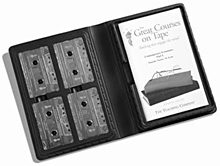"No senior should have to choose between buying food and buying medicine."—President Bill Clinton, Wall Street Journal, July 14, 1999
The president used the above slogan to promote his Medicare reform plan, and politicians of all persuasions are using catchy phrases to promote proposals for saving Social Security, improving education and other high-profile issues that will dominate the 2000 elections. Citizens, however, need more than pithy slogans to make informed decisions. But often the alternative is to wade through mind-numbing details. Moreover, efforts made to understand these issues vie with other demands on people's scarce time.
 One engaging way to improve the trade-off between the time
spent on understanding economic issues and time on other pursuits is Timothy
Taylor's new set of audio tapes, Contemporary Economic Issues.
When walking, running or driving you can listen to one of Taylor's 48
lectures covering the gamut of economic issues, from "Reform of K-12 Education"
to "Can Anything Be Done About International Financial Crashes?" These
30-minute lectures define the issue, give salient facts, use economic
reasoning to compare policy options and conclude with Taylor's observations
on the issue. They are easy to follow and free of economic jargon.
One engaging way to improve the trade-off between the time
spent on understanding economic issues and time on other pursuits is Timothy
Taylor's new set of audio tapes, Contemporary Economic Issues.
When walking, running or driving you can listen to one of Taylor's 48
lectures covering the gamut of economic issues, from "Reform of K-12 Education"
to "Can Anything Be Done About International Financial Crashes?" These
30-minute lectures define the issue, give salient facts, use economic
reasoning to compare policy options and conclude with Taylor's observations
on the issue. They are easy to follow and free of economic jargon.
Take the lecture "Reform of K-12 Education," an important issue for most Americans and where proposals for reform abound. It begins with discussing how K-12 education contributes to economic understanding, and then points out that SAT scores, a proxy for education performance, peaked in 1969, declined until 1980 and remained essentially unchanged since then. Meanwhile, inputs to education have increased over this period; the national pupil/teacher ratio, for example, was 26 in 1969 and today it is around 17. Thus, Taylor indicates "more money can help the schools, but it won't necessarily help." Taylor points out the pros and cons of several reforms, like vouchers, and concludes that no one reform is a cure-all.
As I listened to this lecture, I recalled the famous British economist Joan Robinson's statement: "The purpose of studying economics is not to acquire a set of ready-made answers to economic questions, but to learn how to avoid being deceived by economists," (a quote from another of Professor Taylor's lecture series). Listening to this lecture won't make you an expert on education reform, but it will enable you to determine who is and isn't an expert. Also, it will help the listener determine what questions to ask about proposed education remedies.
Just as most people don't read the Encyclopedia Britannica cover to cover, you can select lectures that are of interest to you. In fact, the way the lectures are ordered encourages selective listing; lectures on the same topic are not grouped together. Take health care, for example: Lecture 5 is "Financing the Health-Care Industry" and Lecture 29 is "The Government in Health Care—Medicare and Medicaid." I listened to 12 of the 48 lectures.
Some of these lectures, however, passed up the opportunity to illustrate the fundamentals of economic reasoning. In his lecture "The Shaky Foundations of Social Security," Taylor lucidly explains why we have a Social Security problem and the options for solving it. He concludes by saying Social Security is "a breakdown waiting to happen." Before finishing he could have reiterated a point he made earlier that "all the ways of saving Social Security involve really higher taxes or lower benefits." Then he could have stated that this dilemma illustrates the well-known economic fundamental: "There is no such thing as free lunch."
Listening to these lectures reveals why Taylor is the recipient of teaching awards from Stanford University and the University of Minnesota. His presentations' facts and concepts are easy to grasp. Also, his use of historical examples and quotes from economists and other notables make his lectures enjoyable, as well as informative; and his use of economic reasoning often brings surprising insight. For example, from Dickens' A Christmas Carol, did you know that Bob Cratchit was a better economist than Ebenezer Scrooge? Get Taylor's tapes, and in his first lecture find out why.





